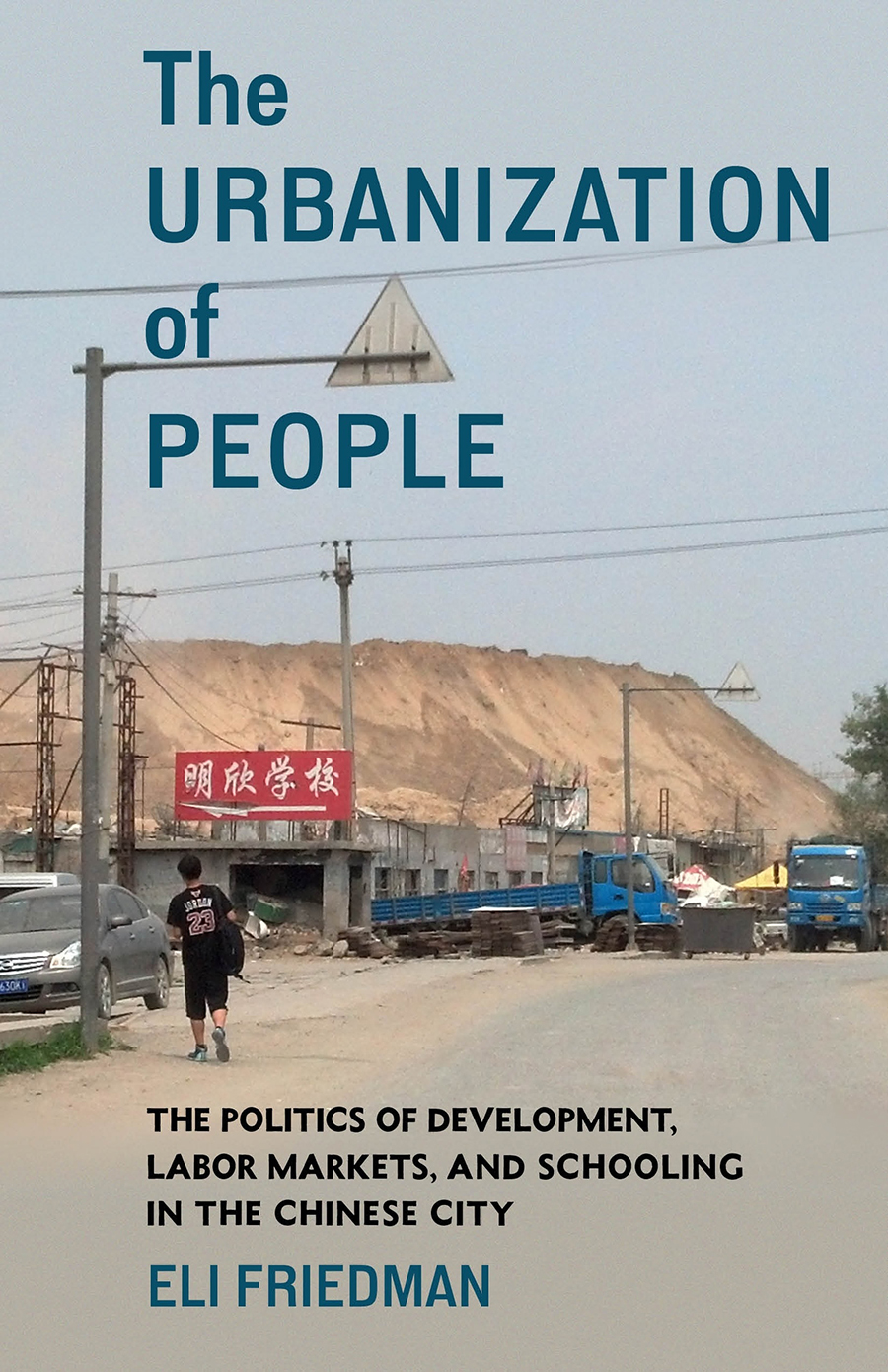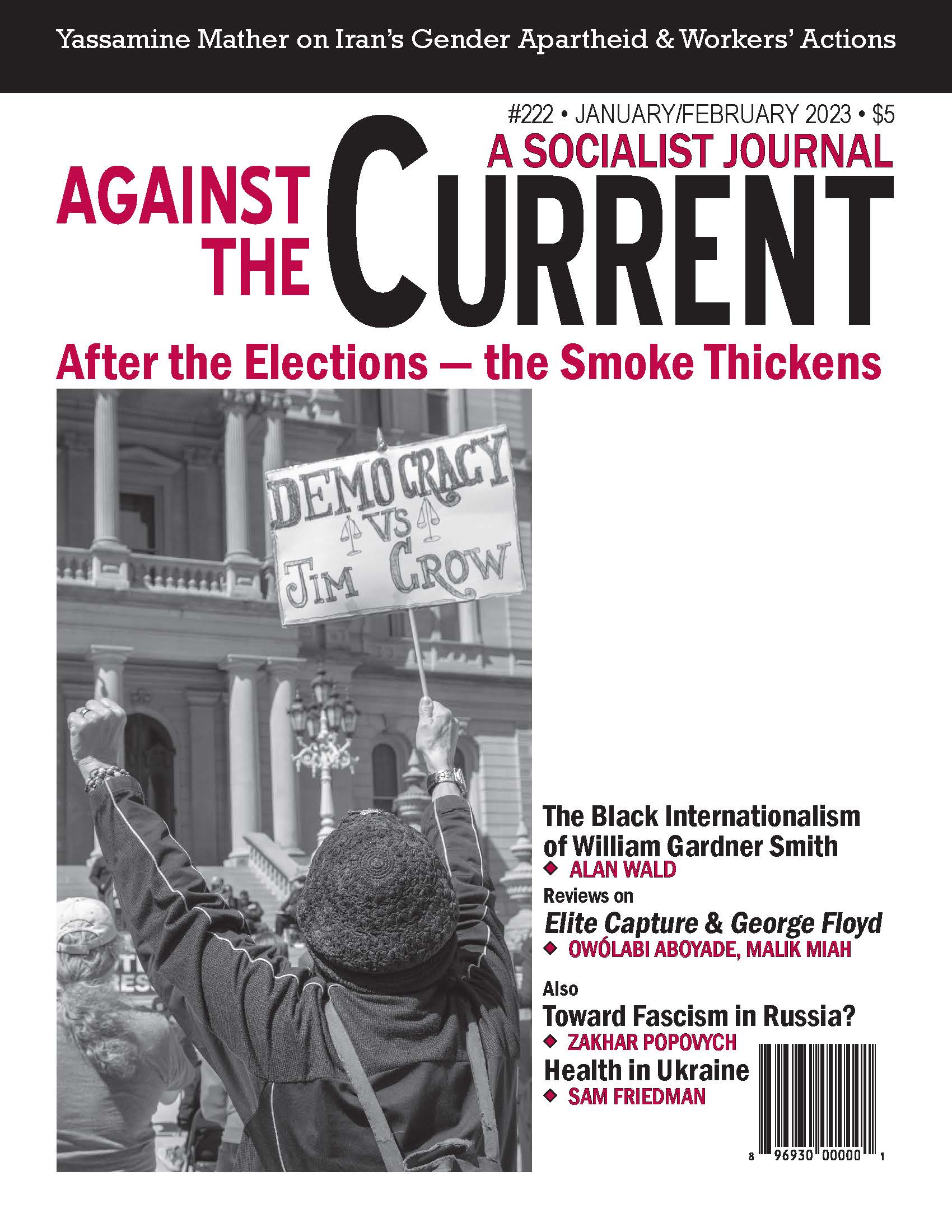Against the Current, No. 222, January/February 2023
-
The Smoke Thickens
— The Editors -
Inequality, Gender Apartheid & Revolt
— Suzi Weissman interviews Yassamine Mather -
Workers' Protests in Early December
— Yassamine Mather -
Student Strikes, Regime Cracks
— Yassamine Mather -
Repression Continues to Grow in Nicaragua
— William I. Robinson -
Queering "A League of Their Own"
— Catherine Z. Sameh -
A Radical's Industrial Experience
— David McCullough -
A New Day for UAW Members?
— Dianne Feeley - Ukraine's War of Survival
-
Future Struggles in Ukraine
— Sam Friedman -
Russia's Road Toward Fascism
— Zakhar Popovych - Race and Class
-
The Black Internationalism of William Gardner Smith
— Alan Wald -
Movement Challenges
— Owólabi Aboyade (William Copeland) -
George Floyd, A Life
— Malik Miah - Police Murder and State Coverup
- Reviews
-
Out of the Two-Party Trap
— Marsha Rummel -
Feminists Tell Their Own Stories
— Linda Loew -
Working-Class Fault Lines in China
— Listen Chen - In Memoriam
-
Mike Davis, 1946-2022
— Bryan D. Palmer
Listen Chen
The Urbanization of People:
The Politics of Development, Labor Markets, & Schooling in the Chinese City
By Eli Friedman
Columbia University Press, 2022, 352 pages, $35 paperback.

IN 2021 THERE were 293 million internal migrant workers in China.(1) Although they constitute 40% of the national workforce, migrants are largely barred from accessing social services like public housing, education and healthcare in the cities where they work. These exclusions are held in place by China’s hukou, or household registration, system first put in place by the Chinese Communist Party in the late 1950s in an effort to control migration in service of central planning.
One of the most disruptive effects of the hukou system has been to keep migrant parents separated from their children. While by 2013 roughly 70% of all rural-to-urban migrants were living in families rather than solo (either as single people or separated from their spouse and/or children),(2) migrant workers continue to face profound difficulties accessing social services in cities. One of the chief motivations for obtaining urban hukou, for migrant workers with children, is in order to access education.
In The Urbanization of People, sociologist Eli Friedman explores how migrant workers have fared in China’s recent urbanization, focusing on the precarity of their access to education. Education provides an ideal window into technocratic methods of population control that Friedman successfully argues produce migrant workers as a socially excluded, “surplus” population struggling to access basic social services.
The book’s chief strength is the detailed picture it paints of migrant workers’ lives in Beijing, and the uphill battle they climb in trying to provide education for their children. While it appears nationwide that the majority of migrant children are enrolled in public schools, Friedman homes in on migrant families in Beijing who are excluded from public education and forced to turn to private migrant schools.
These schools, in addition to relying exclusively on tuition for funding and being severely under-resourced, regularly face arbitrary closures, demolitions and displacement, compounding the already insecure lives of migrant children and incredibly high rates of student turnover.
In addition to research on school closures and government policies that guard access to urban hukou and public education, Friedman quotes from interviews primarily with migrant parents, school administrators and teachers, which add a narrative texture to the book’s findings.
A chapter on teachers in migrant schools, themselves often migrants who lack official teaching credentials and survive on low wages that necessitate they take on additional jobs in the summer, is particularly poignant in its portrayal of the intense affective bonds teachers form with students. I found myself wanting more of that ethnographic richness throughout the text.
Lay persons as well as academics will find Friedman’s meticulous research valuable for their understanding of migrant workers’ social positions in China. His exploration of the way suzhi, or “human quality” is deployed to manage urban populations will appeal to any reader interested in understanding China’s turn away from being the world’s sweatshop toward high-tech and value-added industries.
Indeed, migrant workers appear in Friedman’s study as glaring casualties of the effort to launch China out of developing country status via the well-trodden pathway of capitalist modernization.
Political versus Economic?
Where the book faltered, for me, was in Friedman’s interpretations of his findings and broader theoretical framework. His thinking-through of the production of migrant workers as “surplus” is heavily inflected by a conceptual division between the “political” and “economic” that, while having a commonsense appeal, elides a more dialectical understanding of what Marxists refer to as the relationship between base and superstructure.
Despite naming throughout the text the puzzling contradiction between the economic necessity of migrant workers’ labor and the processes, often carried out by the state, that threaten their survival, the book does far more to explicate how migrant workers are excluded than why.
For Friedman, migrant workers are expelled from hegemonic urban centers because “they do not provide a kind of labor that comports with the state’s vision for economic upgrading.” (107) While this necessarily engages with China’s concerted effort to transition its economy toward higher value added industries, readers not already familiar with modern Chinese history will likely fail to grasp the extent to which post-Mao ideology positions certain subjects as anachronistic threats to Chinese modernity through various processes of market-assisted depoliticization.
Thus the peasant, figured as a deeply political agent and protagonist during the Cultural Revolution, now comes to signify the excesses and backwardness of the Maoist revolutionary project.
That Friedman never explicitly engages with how the migrant worker is coded by urban classes as a peasant (or former peasant) struck me as a peculiar omission. Mapping the shift of China’s rural-urban divide is a clear and parsimonious way of historicizing the subaltern status of the migrant worker. It immediately brings into relief the broader, semi-core-periphery relationship between the city and the countryside that persists across China’s post-revolutionary and post-socialist eras.
For readers intrigued with the question of why contemporary capitalist ideology treats the figure of the migrant worker repellent while at the same time relying on their labor power, the answer lies outside of Friedman’s book.
I also found myself wanting Friedman to provide more context on the class shadings both within migrant workers, and between them and middle-class urbanites and the urban working poor.
Of the migrant parents Friedman interviewed in the chapter on parents’ experiences, the four whose employment background was included in the book were small business owners. This gives the impression that petty-bourgeois migrant workers are those most likely to be able to bring their children to live with them in the city. (A 2011 study found that the longer migrant workers reside in a single city, the more likely they are to be self-employed, suggesting that self-employment is either an outcome or condition of geographic stability.(3))
In particular, I wonder how non-self-employed migrants with children still living in their place of hukou registration thought about education — does it hold for them the promise of class uplift, as it appeared to for the migrants Friedman interviewed? Additionally, how do migrants’ experiences of social exclusion and surplusness compare with the urban unemployed, many of whom were laid off from secure state-sector jobs as a result of liberalization?
Having a sense of the broader field of class-based exclusion could have buttressed Friedman’s argument that in the Chinese context, surplus-ness has more to do with political imperatives than a formally economic relationship to wage labor, as some Marxist theories of the lumpenproletariat suggest.
Modes of Population Management
The Urbanization of People concludes with an attempt to situate its findings in China in a global context by way of comparing and contrasting other moments and spaces of “capitalist population management,” for example, settler colonialism and slave labor. I found this section to be the most analytically jarring, particularly Friedman’s choice to engage with race, if only to argue it’s not relevant in China while at the same time appearing to naturalize it as a category:
“In the absences of a demographically abundant and politically available racialized other that could be sourced externally and incorporated into capitalist production, the Chinese state inserted a social break within the Han race.” (235)
Again, it seems to me that locating the social status of migrants within the framework of China’s urban-rural divide, one which follows determinate economic processes of accumulation and exploitation, makes more sense that introducing race without adequately explicating what its contingencies are in the Chinese context.
Friedman’s suggestion that the state is the actor that created a division between urban and rural Han workers pivots away from divisions within the working class that emerge from short-term and limited but nonetheless antagonistic class interests — such as those between a relatively new middle class and sectors of the working class left behind by the push to ascend the ranks of global capitalism. This would ostensibly include not only migrant workers but those ejected from the state sector and, along a different political fault line, nationally-oppressed peoples.
By pivoting quickly to a global comparison, Friedman misses an opportunity to dwell in the historical arc of modern China and contribute to crucial discussions of how divisions reinforced by state policies play out within the working class. Are these social breaks not also reproduced by, for example, the tight relationship between the urban middle class and the state?(4)
I’d recommend that readers keen to develop a more historicized understanding of migrant workers supplement Friedman’s research with books that more clearly identify the repercussions of China’s capitalist turn on peasants and, in particular, rural women. (Although Friedman relies heavily on access to state-subsidized social reproduction as a delineator of surplus-ness, I was surprised to find that the book largely treats migrants as a gender-less population.)
Two books that I found helpful in thinking through the consequences of Friedman’s findings are Yan Hairong’s New Masters, New Servants, an ethnographic study on women migrant domestic workers, and Alexander Day’s The Peasant in Postsocialist China.
One could argue that the eclecticism in Friedman’s use of sources and borrowing of conceptual tools from other thinkers reflects the interdisciplinary nature of his subject of study. For me it felt chaotic and at times obfuscating, performing, perhaps, the fraught relationship between academic productions of knowledge and anti-capitalist political praxis. I couldn’t help but read a social-democratic longing for a benevolent state that invests in the social reproduction of all workers thus filling in the gaps and elisions created by Friedman’s lack of theoretical precision.
The Urbanization of People offers excellent raw material on a profoundly subaltern working class social group in China. Many readers will appreciate Friedman’s eclectic use of conceptual tools from a wide range of thinkers and disciplines. I, however, was left with more questions than answers from his theoretical scaffolding, which, in contrast to the depth of his qualitative research, felt underdeveloped and hastily swept across too much ground to be useful.
Nevertheless, the book supplies crucial evidence in support of a working-class movement that must, as a foundational strategy, bridge subaltern class interests within and beyond China.
Notes
- https://clb.org.hk/content/migrant-workers-and-their-children
back to text - Wang, C., Zhang, C., Ni, J., Zhang, H., & Zhang, J. (2019). “Family migration in China: Do migrant children affect parental settlement intention?” Journal of Comparative Economics.
back to text - Connelly, R., Roberts, K., & Zheng, Z. (2011). “The settlement of rural migrants in urban China — some of China’s migrants are not ‘floating’ anymore,” Journal of Chinese Economic and Business Studies, 9(3), 283-300.
back to text - Goodman, D. S. (2016). “Locating China’s Middle Classes: social intermediaries and the Party-state.” Journal of Contemporary China, 25(97), 1-13.
back to text
January-February 2023, ATC 222

